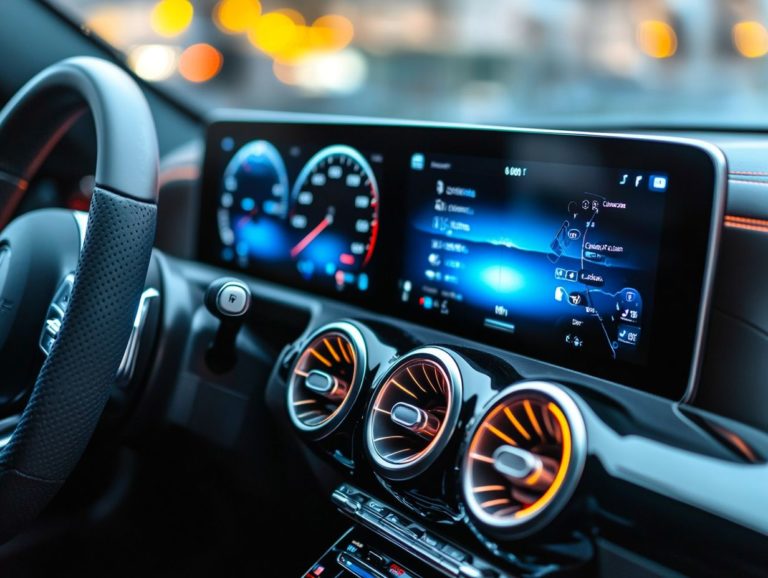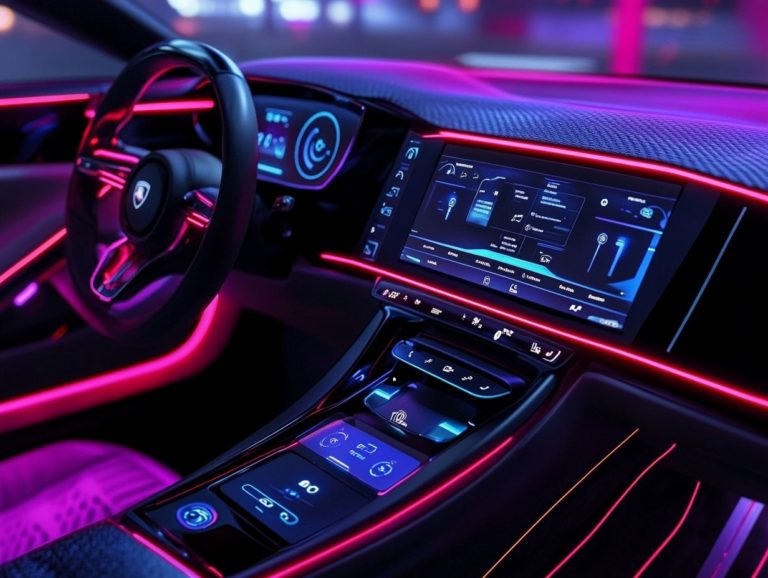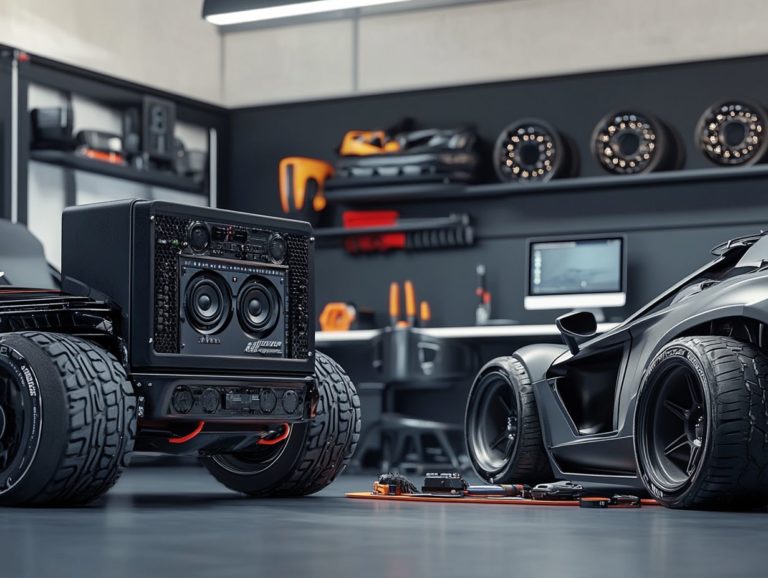Best Visibility Features in Vehicles
In today’s fast-paced world, driving can be both exhilarating and daunting, especially with constantly shifting road conditions and potential hazards lurking around every corner.
Modern vehicles come equipped with impressive visibility features designed to enhance safety and ensure that each journey is as smooth as possible.
From automatic headlights that adjust to changing light conditions to advanced collision warning systems that keep you aware of your surroundings, these technologies are crafted to improve visibility and empower you to navigate with confidence.
This article explores the top features that elevate driving safety, examining their pros and cons while showing how they adapt to various driving scenarios. Join us as we dive into the latest advancements in automotive technology that can truly transform your driving experience.
Contents
- Key Takeaways:
- 1. Automatic Headlights
- 2. Rearview Cameras
- 3. Blind Spot Monitoring
- 4. Lane Departure Warning
- 5. Adaptive Cruise Control
- 6. Parking Assist
- 7. 360-Degree Camera System
- 8. Automatic High Beams
- 9. Rain-Sensing Wipers
- 10. Collision Warning System
- 11. Rear Cross Traffic Alert
- 12. Head-Up Display
- 13. Active Park Assist
- 14. Pedestrian Detection
- 15. Emergency Braking System
- How Do These Features Improve Visibility and Safety?
- Frequently Asked Questions
- What are the best visibility features in vehicles?
- How do advanced rearview cameras improve visibility?
- What is blind spot monitoring and how does it enhance visibility?
- Can lane departure warning improve visibility?
- How do adaptive headlights contribute to better visibility?
- Are there any other visibility features that are important for vehicles?
Key Takeaways:
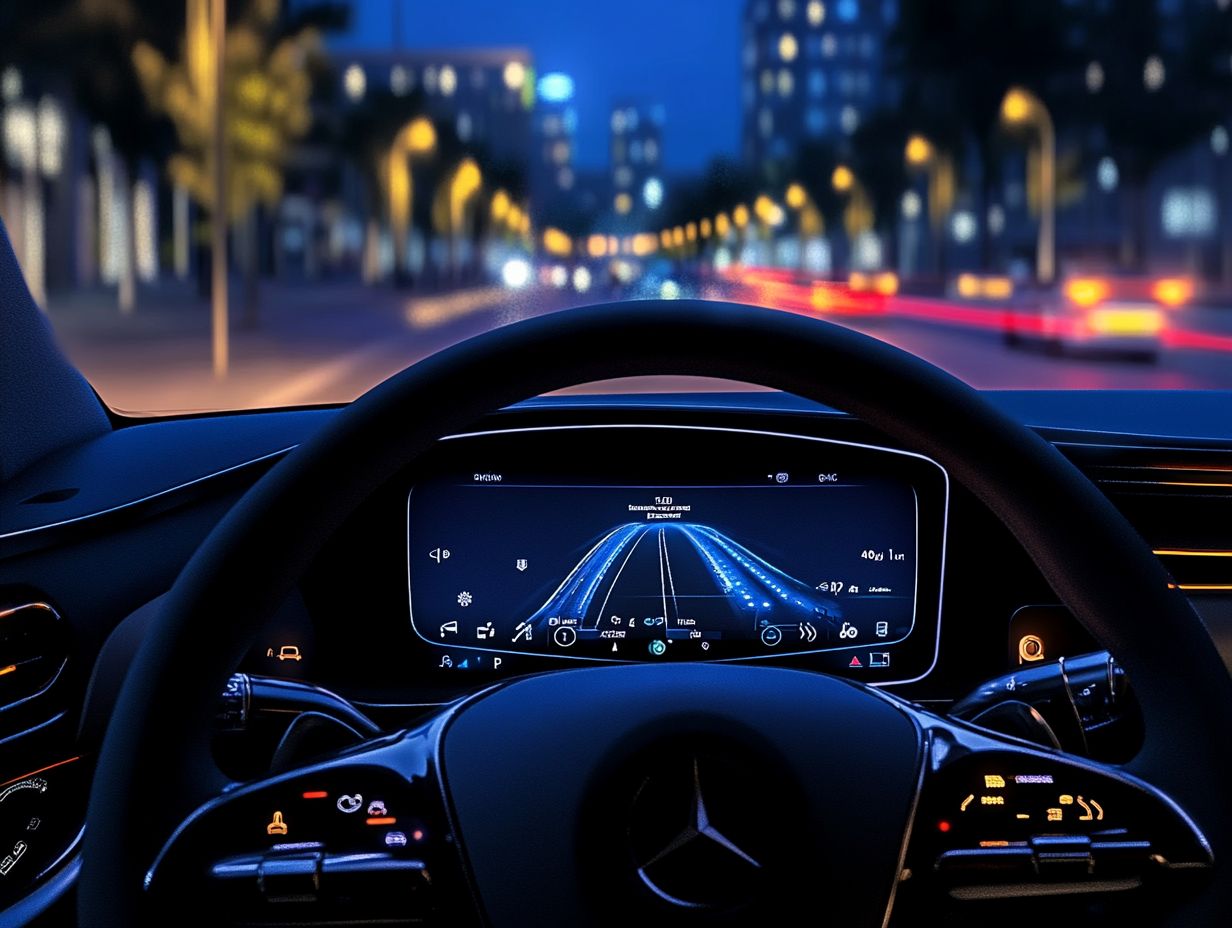
- Automatic headlights improve safety by adjusting to outside light.
- Rearview cameras help in parking and reversing with ease.
- Blind spot monitoring alerts you to hidden vehicles, reducing accident risks.
1. Automatic Headlights
Automatic headlights are a crucial safety feature in modern vehicles, enhancing visibility for shorter drivers and improving overall driving dynamics. This technology allows for safer navigation in dark areas and bad weather.
These smart systems adjust the brightness and direction of your headlights based on real-time light conditions. This ensures optimal illumination without blinding oncoming traffic. For shorter drivers, this adaptability is particularly beneficial, helping you see road signs, pedestrians, and obstacles more clearly.
Reliable brands like Subaru and Honda lead the way in integrating such innovative technologies, merging automatic headlights seamlessly with other essential safety features like lane departure warnings and collision mitigation systems. This comprehensive approach prioritizes visibility while boosting your safety and confidence on the road.
2. Rearview Cameras
Rearview cameras are your critical visibility allies, helping you avoid visibility villains like blind spots and unexpected obstacles while reversing. This technology enhances safety and convenience for families on the go.
These advanced systems provide a crystal-clear view of what’s behind you, making it easier to spot small children or pets that might unexpectedly dart into your path. When you’re behind the wheel of a vehicle equipped with this technology especially from top brands like Toyota, Nissan, and Kia you’ll often find additional family-friendly features like proximity sensors and cross-traffic alerts.
By incorporating these systems, manufacturers put safety first, ensuring that every family outing is as secure as possible.
In bustling parking lots, for example, the reassurance of rearview cameras significantly reduces anxiety, allowing you to navigate tight spaces confidently and protect your loved ones from potential accidents.
3. Blind Spot Monitoring
Blind spot monitoring systems are advanced safety features designed to eliminate those pesky visibility issues by alerting you to vehicles in adjacent lanes. This feature boosts your safety and gives you confidence, especially if you re behind the wheel of a compact SUV with its elevated seating position.
These systems also employ a combination of radar and cameras to constantly scan those tricky blind zones. The moment another vehicle is detected, you ll receive immediate notifications through visual or auditory alerts, keeping you informed and aware.
This technology is particularly invaluable when it comes to preventing accidents during lane changes or merges, ultimately lowering the risk of collisions. You ll find these systems seamlessly integrated into various models from esteemed manufacturers like Ford, Hyundai, and Mazda, often working in harmony with other driver assistance features such as lane-keeping assist and adaptive cruise control.
With such a comprehensive safety network at your disposal, you re not just protecting your passengers, but you re also enhancing your driving experience. Don’t miss out on improved safety!
4. Lane Departure Warning
Lane departure warning systems are advanced safety features found in reliable vehicles, designed to alert you when you unintentionally drift out of your lane, thereby enhancing your driving dynamics and overall road safety.
These systems typically utilize a blend of cameras and sensors to monitor the lane markings on the road, providing you with auditory or visual alerts if you stray too close to the edges. These systems help prevent accidents and significantly reduce driver fatigue during those long journeys.
Brands like Volvo have seamlessly woven these technologies into their vehicles, often pairing them with adaptive cruise control and collision warning systems to elevate safety even further. Similarly, Audi employs their lane assistance systems, offering you an extra layer of security by gently adjusting steering inputs to help maintain your lane position on highways.
This harmonious integration of technologies embodies a growing trend toward smarter, safer driving experiences.
5. Adaptive Cruise Control
Adaptive cruise control is a game-changer in driver assistance technology that automatically adjusts your vehicle’s speed based on the car in front of you. This feature makes driving easier and safer.
Utilizing advanced sensors and radar, this system detects the speed and distance of surrounding vehicles, allowing it to make real-time adjustments without requiring your constant manual input. If you re embarking on a long-distance journey, you’ll find this feature reduces fatigue remarkably, enabling a more relaxed driving style especially during those extended highway stretches.
In vehicles from esteemed brands like Honda, Nissan, and Chevrolet, adaptive cruise control integrates effortlessly with existing safety features, such as lane-keeping assist and automatic emergency braking. This creates a comprehensive suite of assistance that boosts your comfort and enhances overall vehicle safety.
6. Parking Assist
Parking assist technologies elevate your driving experience, acting as your visibility helpers and making it a breeze to navigate tight parking spots. This is especially helpful in compact SUVs, where visibility can be a challenge.
These advanced systems harness a blend of sensors, cameras, and cutting-edge algorithms to detect nearby objects, evaluate available space, and deliver real-time feedback. If you re on the shorter side and find it tough to see over the dashboard, these technologies will ease the stress of parking maneuvers, instilling greater confidence on the road and reducing the likelihood of accidents.
Brands like Subaru and Ford have seamlessly integrated these features into their vehicles. Subaru s EyeSight Driver Assist Technology and Ford s Active Park Assist exemplify the growing focus on safety and convenience in today s automotive landscape.
7. 360-Degree Camera System
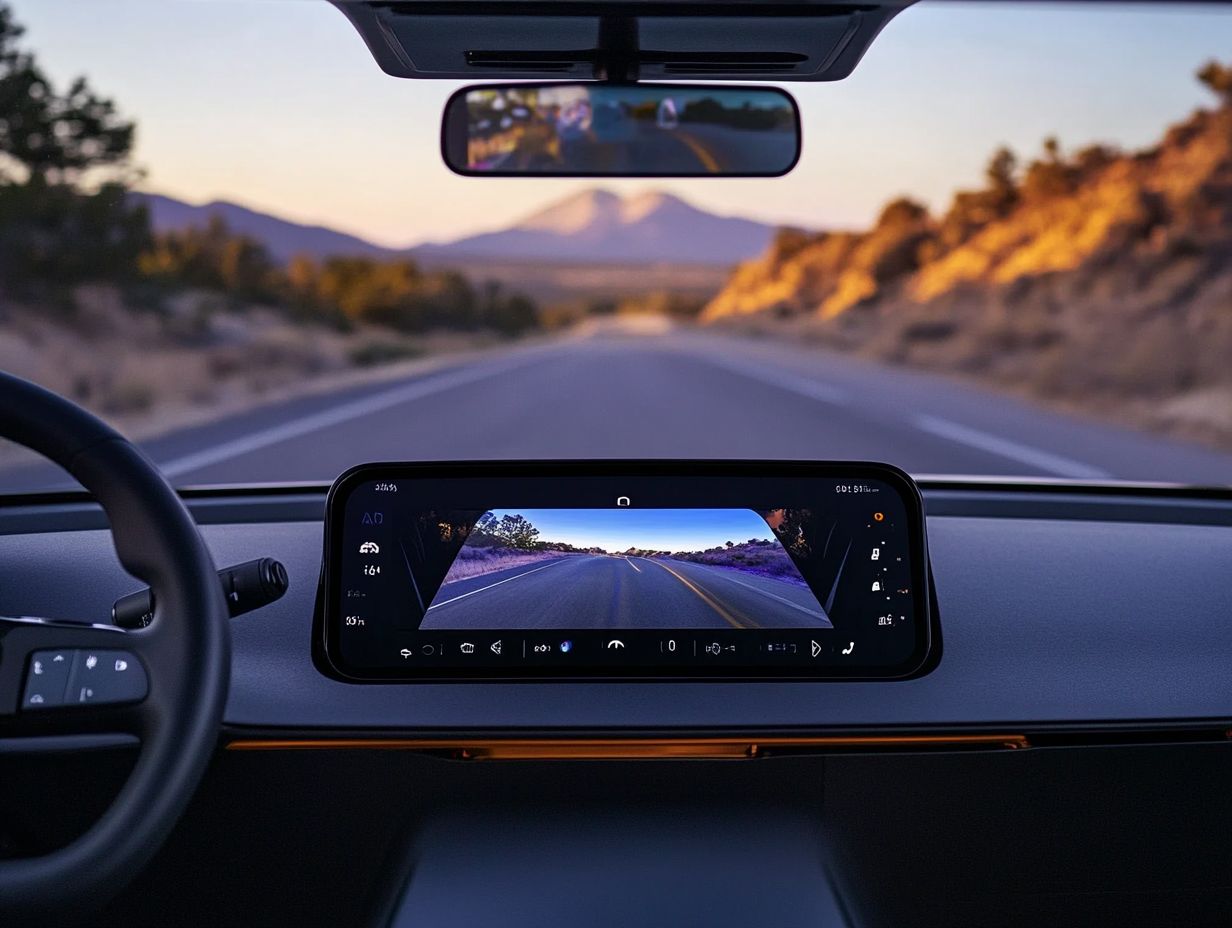
The 360-degree camera system is an exceptional safety feature that offers you a bird’s-eye view of your surroundings. It effectively banishes blind spots, becoming your visibility ally during parking and low-speed maneuvers.
This innovative technology employs multiple cameras placed around your vehicle. These cameras capture real-time video feeds, seamlessly stitched together to create an overhead view.
Such a comprehensive visual aid significantly enhances your awareness in tight urban settings. Navigating crowded streets and parking structures can often prove challenging.
Leading manufacturers like Audi and Kia utilize this cutting-edge solution in their premium models. This integration elevates your driving confidence and promotes safer driving experiences.
By using these advanced systems, you can make more informed decisions in complex environments. This greatly reduces the likelihood of collisions and accidents.
8. Automatic High Beams
Automatic high beams are essential safety features that significantly enhance your visibility during nighttime driving. They intelligently adjust light intensity based on oncoming traffic, serving as your visibility helpers to boost overall driving safety.
These systems use sensors that detect other vehicles and assess varying road conditions. This ensures you benefit from optimal lighting without unintentionally blinding other drivers.
In well-engineered vehicles, especially those from manufacturers like Toyota and Hyundai, this technology integrates seamlessly with additional safety features. These include adaptive cruise control and lane-keeping assist.
This harmonious combination enables you to navigate dimly lit roads with confidence. You can trust that your vehicle adjusts its lighting for maximum clarity while safeguarding the well-being of all road users.
9. Rain-Sensing Wipers
Rain-sensing wipers represent an innovative safety feature that automatically adjusts their speed according to rainfall intensity. This ensures optimal visibility and enhances your driving experience during adverse weather conditions.
The magic happens through sensors that detect the amount of water on your windshield. This allows you to focus on the road ahead rather than fiddling with the wipers.
By maintaining clear visibility, these wipers play a vital role in preventing accidents caused by poor weather. Many trusted car brands, including Ford, Mazda, and Nissan, have integrated this technology into their vehicles.
This thoughtful feature enables you to navigate rain-soaked roads with confidence. You can trust that your vehicle adapts effortlessly to changing weather conditions.
10. Collision Warning System
Collision warning systems, which alert drivers of potential dangers, are essential safety features. Designed to enhance your awareness, they act as deterrents against visibility villains, ultimately preventing accidents.
These systems employ a combination of cameras and sensors to monitor your surroundings. They detect any imminent collisions with other vehicles, pedestrians, or objects.
By delivering timely audio or visual warnings, they grant you critical seconds to respond appropriately. Consider Subaru’s EyeSight system and Toyota’s Pre-Collision System; these advanced features have demonstrated remarkable efficacy.
They significantly reduce rear-end accidents. Their integration into popular models showcases the automobile industry’s commitment to safety, aimed at creating a more secure driving experience for everyone navigating the roads.
11. Rear Cross Traffic Alert
Rear cross traffic alert systems are critical safety features that enable you to navigate the perils of visibility when reversing out of parking spaces. They offer crucial alerts about approaching vehicles, significantly enhancing overall safety in compact SUVs.
This innovation is especially advantageous for shorter drivers, who often face challenges with limited sightlines in tight parking scenarios. Utilizing radar sensors, these systems detect vehicles approaching from both sides and provide alerts through visual or auditory signals.
Manufacturers like Hyundai and Mazda have acknowledged this necessity and have seamlessly integrated advanced rear cross traffic alert features into many of their models.
These enhancements not only instill peace of mind but also markedly reduce the likelihood of accidents. Imagine driving with complete peace of mind! This makes urban driving safer for everyone, particularly for those who might struggle with spatial awareness.
12. Head-Up Display
The head-up display is a state-of-the-art safety feature that projects critical driving information directly onto your windshield, serving as a visibility enhancer by helping you keep your eyes on the road and enhancing overall safety.
This technology relays speed and navigation details and alerts you to potential hazards in your surroundings. By placing essential data right in your line of sight, it minimizes distractions and boosts your situational awareness a critical aspect of safe driving.
Various esteemed car models, including those from Ford and Audi, have seamlessly integrated these displays into their designs, reflecting their commitment to elevating both comfort and security. As you grow accustomed to this feature, you may find your confidence behind the wheel soaring, leading to a more enjoyable and secure driving experience.
13. Active Park Assist
Active park assist is an innovative safety feature designed to make parking easier, taking the wheel (figuratively speaking) while offering guidance for safe maneuvers in reliable vehicles.
This advanced technology shines especially bright when you’re navigating tight urban environments or compact spaces, where parking can often seem like a big challenge. By harnessing a series of sensors, active park assist detects suitable parking spots and smoothly guides your vehicle into place, all while alleviating stress and enhancing safety.
Manufacturers like Honda, Nissan, and Chevrolet have embraced this system in their models, elevating your driving experience and promoting best practices in vehicle handling. With this feature, even if you’re behind the wheel of a smaller vehicle, finding a parking spot becomes a breeze.
Ultimately, making urban living all the more accessible!
14. Pedestrian Detection
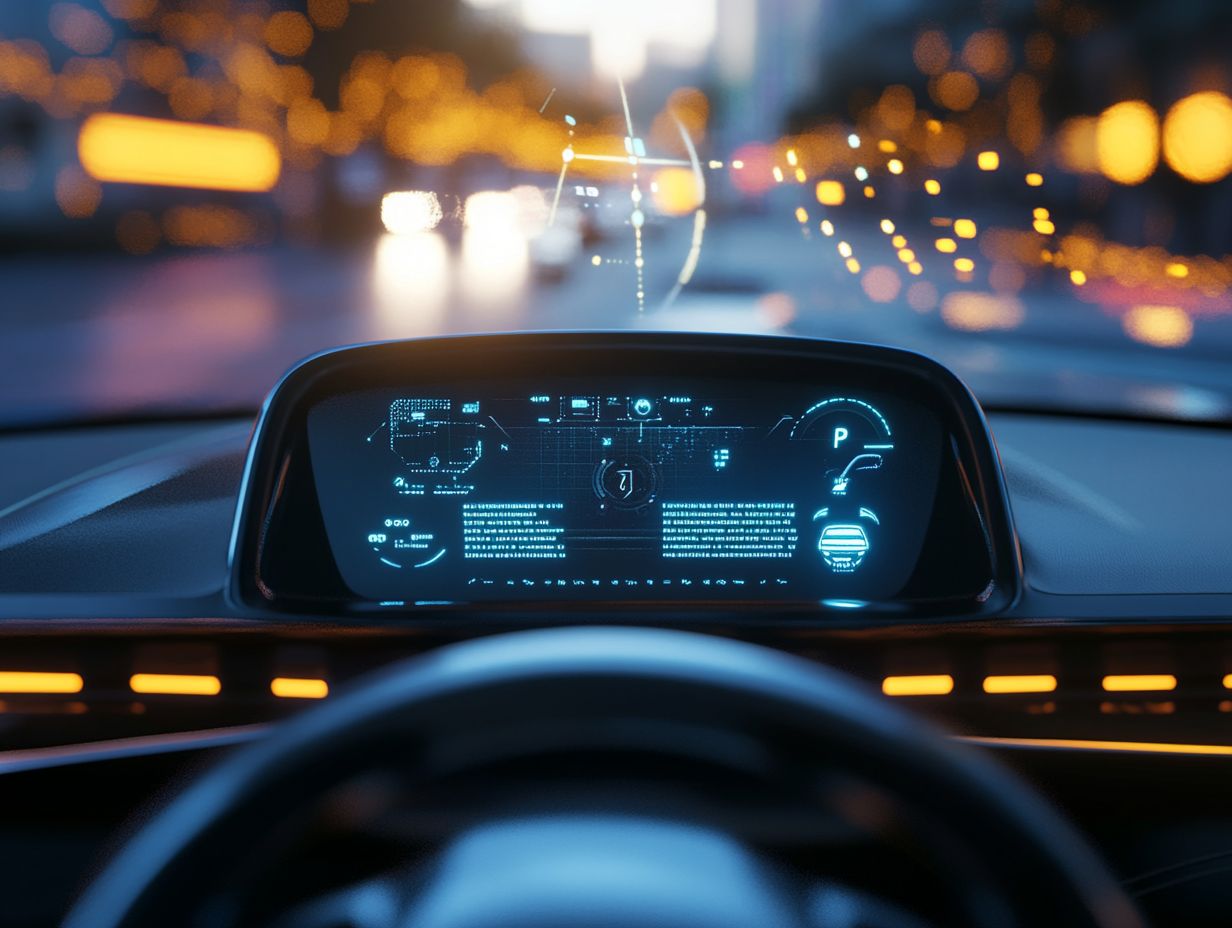
Pedestrian detection systems are critical safety features that keep a vigilant eye on your surroundings, serving as a crucial line of defense against visibility challenges while enhancing your overall safety in dependable vehicles.
These cutting-edge technologies seamlessly integrate a blend of sensors, cameras, and smart technology to analyze and pinpoint potential risks in real-time, ensuring that you re promptly alerted to pedestrians in your path. The importance of such systems becomes even more evident in bustling urban areas, where foot traffic is abundant and the likelihood of accidents rises.
Take brands like Subaru and Toyota, for instance. Subaru incorporates these systems through their EyeSight technology, utilizing cameras to detect pedestrians and automatically apply the brakes when needed. Toyota boasts its Pre-Collision System, which leverages ultrasonic sensors which use sound waves to detect objects around the vehicle and advanced algorithms to improve visibility and avert collisions.
These systems show a commitment to safety and the necessity for vehicles to adapt to increasingly pedestrian-friendly city landscapes.
15. Emergency Braking System
Emergency braking systems are essential safety features. They automatically engage the brakes when a potential collision is detected, improving safety for everyone in your car.
These systems use advanced sensors, cameras, and radar to evaluate your surroundings in real time. They employ smart systems to analyze potential hazards and decide when to intervene.
Manufacturers like Hyundai and Volvo have integrated these systems into their models. This commitment to driver safety elevates your driving experience and lowers accident risks.
How Do These Features Improve Visibility and Safety?
Modern vehicles combine advanced visibility features and safety technologies. This integration enhances your overall safety and boosts your confidence on the road.
Such enhancements make driving safer and significantly influence your buying decisions. When considering options like the Toyota Camry, Honda Accord, or Subaru Outback, features like adaptive headlights and automatic emergency braking can sway your choice.
The Subaru Outback s EyeSight Driver Assist Technology offers extra protection for long journeys. Similarly, the Honda Accord s blind-spot monitoring helps ease your mind while merging lanes.
These features are crucial in a world where vehicle safety is vital. They can greatly impact your driving experience.
What Are the Advantages and Disadvantages of Each Feature?
Each safety feature brings its own advantages and disadvantages. Understanding them helps you make informed buying decisions.
For example, automatic emergency braking can significantly enhance safety by reducing collision risks. However, the costs for these systems vary widely among manufacturers.
Adaptive cruise control adds convenience for long drives, but user experiences on its responsiveness can vary. Exploring the effectiveness and feedback on these technologies helps you identify which safety enhancements fit your needs and budget.
How Can These Features Be Helpful in Different Driving Situations?
Different driving conditions require specific safety features. It’s essential to know how these technologies provide vital assistance.
For instance, adaptive headlights adjust their angle at night, improving visibility and reducing accident risks. On rainy days, rain-sensing wipers automatically adjust their speed, helping you maintain visibility without distraction.
If your vehicle has blind-spot monitoring, it alerts you when another vehicle is in hard-to-see areas. This is especially helpful in heavy traffic or during lane changes.
These advancements ensure a safer and more confident driving experience for you.
What Are the Different Options and Price Ranges for These Features?
Understanding the various options and price ranges for safety features is essential for you as a consumer. This knowledge enables you to make informed decisions when selecting a reliable car packed with modern technologies.
Today, vehicles especially compact SUVs from reputable manufacturers like Subaru and Honda offer a wide range of advanced safety technologies to suit different budgets. For instance, entry-level models typically come equipped with essential features like rearview cameras and basic stability control.
If you step up to mid-range options, you ll find additional perks such as lane-keeping assistance (helps keep the car in its lane) and cruise control that adjusts with traffic. On the luxury end, you can indulge in comprehensive packages that include advanced collision avoidance systems and 360-degree cameras.
By exploring these tiers, you can better understand which models align with your safety needs and financial considerations.
How Can Drivers Ensure Proper Use and Maintenance of These Features?
Ensuring that you use and maintain safety features properly is crucial for maximizing their effectiveness and enhancing your overall driving safety.
Regular checks and timely updates are essential for keeping these systems functioning correctly. Make it a habit to check your safety features during routine vehicle inspections this includes tire pressure, brake systems, and backup cameras. It s also wise to familiarize yourself with the user manual to fully understand the capabilities of features like lane assist or cruise control that adjusts with traffic.
Don t miss out on the latest software updates stay informed to keep your safety features at their best! By staying informed about software updates, you can enhance the functionality of these safety features and ensure they provide the latest advancements in driver support.
Frequently Asked Questions
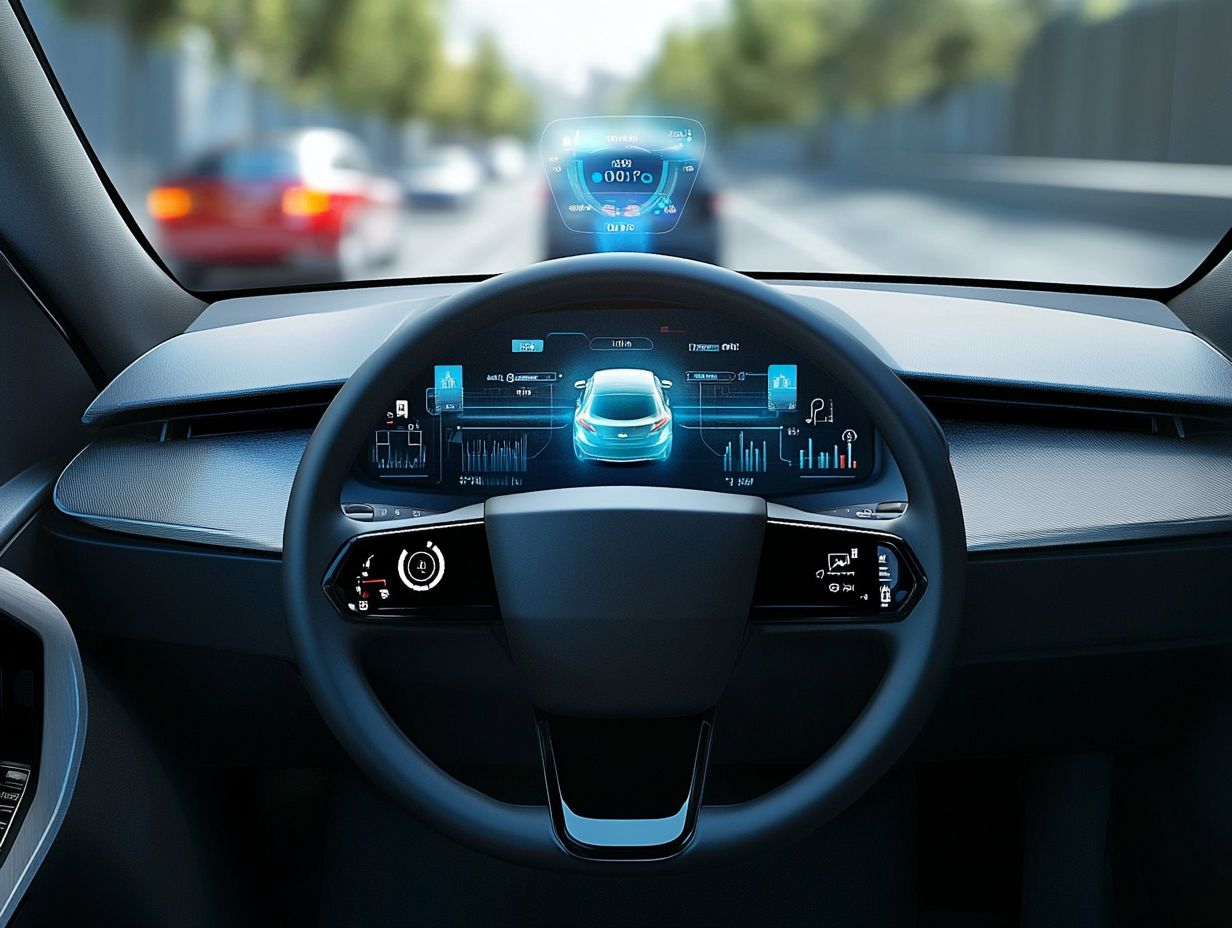
What are the best visibility features in vehicles?
Some of the best visibility features in vehicles include advanced rearview cameras, blind spot monitoring systems, lane departure warning, and adaptive headlights.
How do advanced rearview cameras improve visibility?
Advanced rearview cameras provide a wider and clearer view of the area behind the vehicle, making it easier for drivers to spot any potential hazards or obstacles while backing up.
What is blind spot monitoring and how does it enhance visibility?
Blind spot monitoring uses sensors to detect vehicles in the driver’s blind spots and alerts them with visual or audible signals. This helps drivers be more aware of their surroundings and avoid potential collisions.
Can lane departure warning improve visibility?
Yes, lane departure warning systems use cameras or sensors to monitor the vehicle’s position on the road and notify the driver if they unintentionally drift out of their lane. This can help prevent accidents and improve overall road awareness.
How do adaptive headlights contribute to better visibility?
Adaptive headlights use sensors to adjust the direction and intensity of the headlights based on the vehicle’s speed and steering. This ensures that the road ahead is well-illuminated, providing better visibility for the driver.
Are there any other visibility features that are important for vehicles?
Other important visibility features for vehicles include rain-sensing wipers, auto-dimming rearview mirrors, and high-quality windshield glass that reduces glare and distortion.
What visibility features do you find most helpful?

